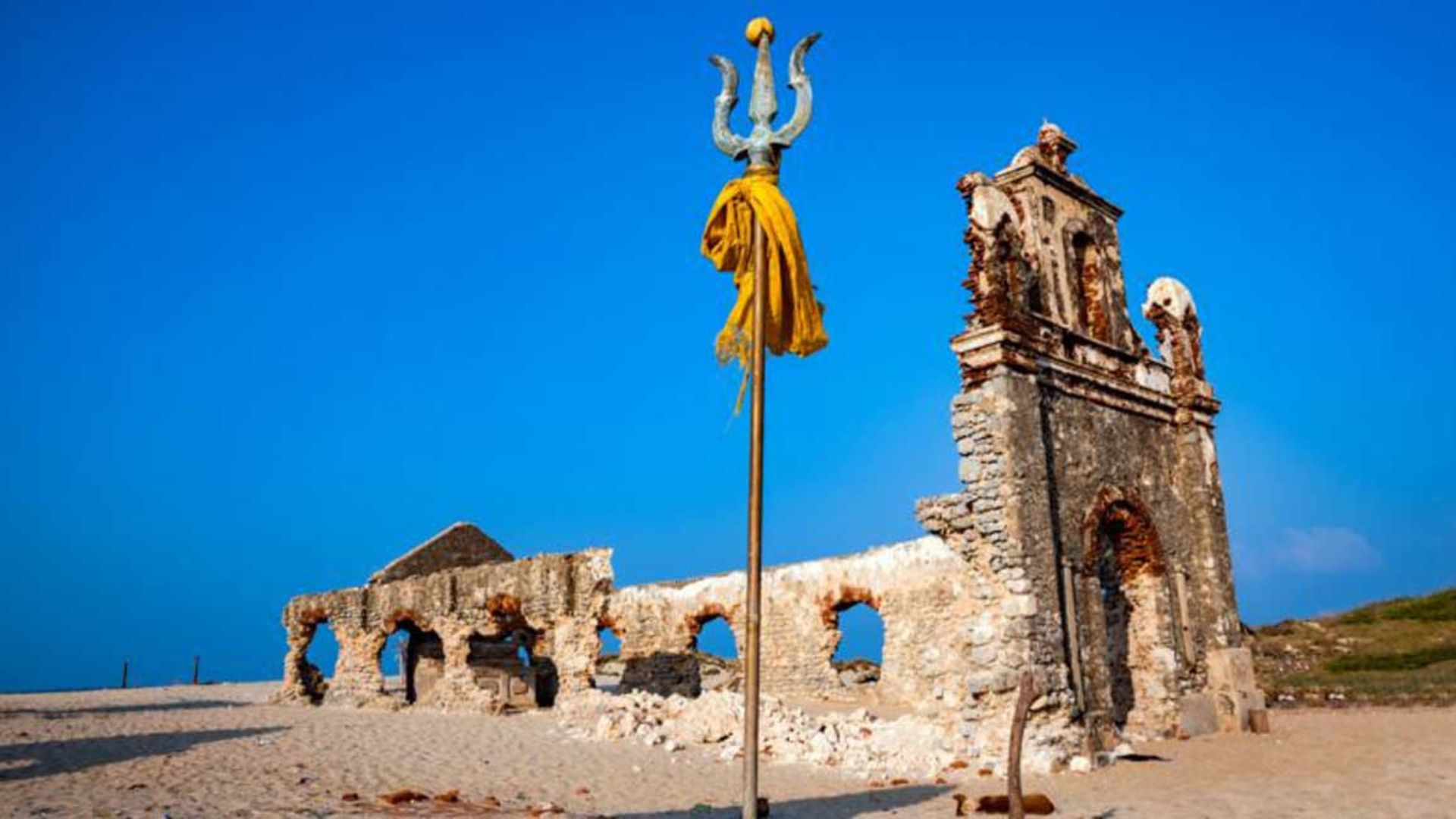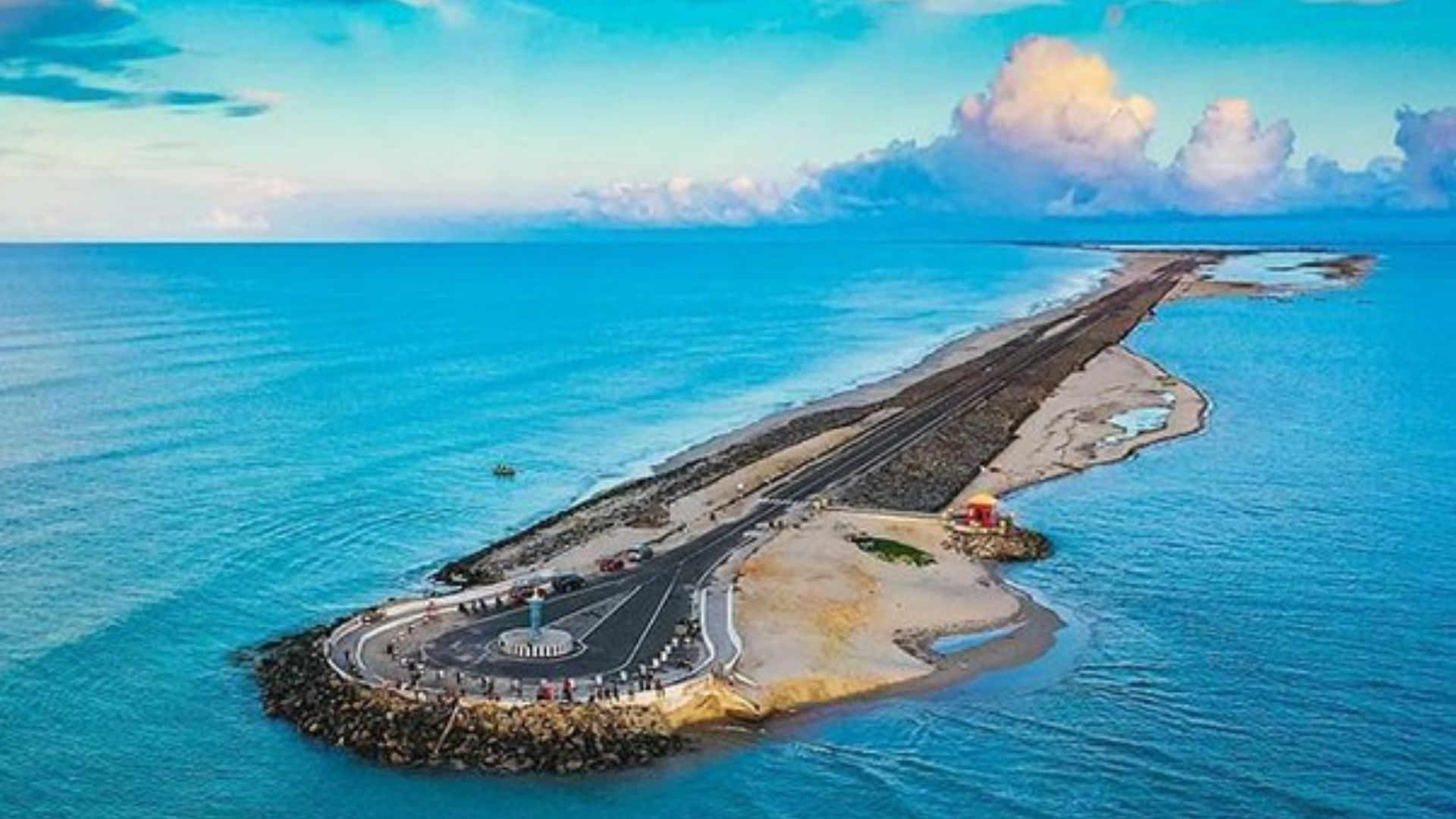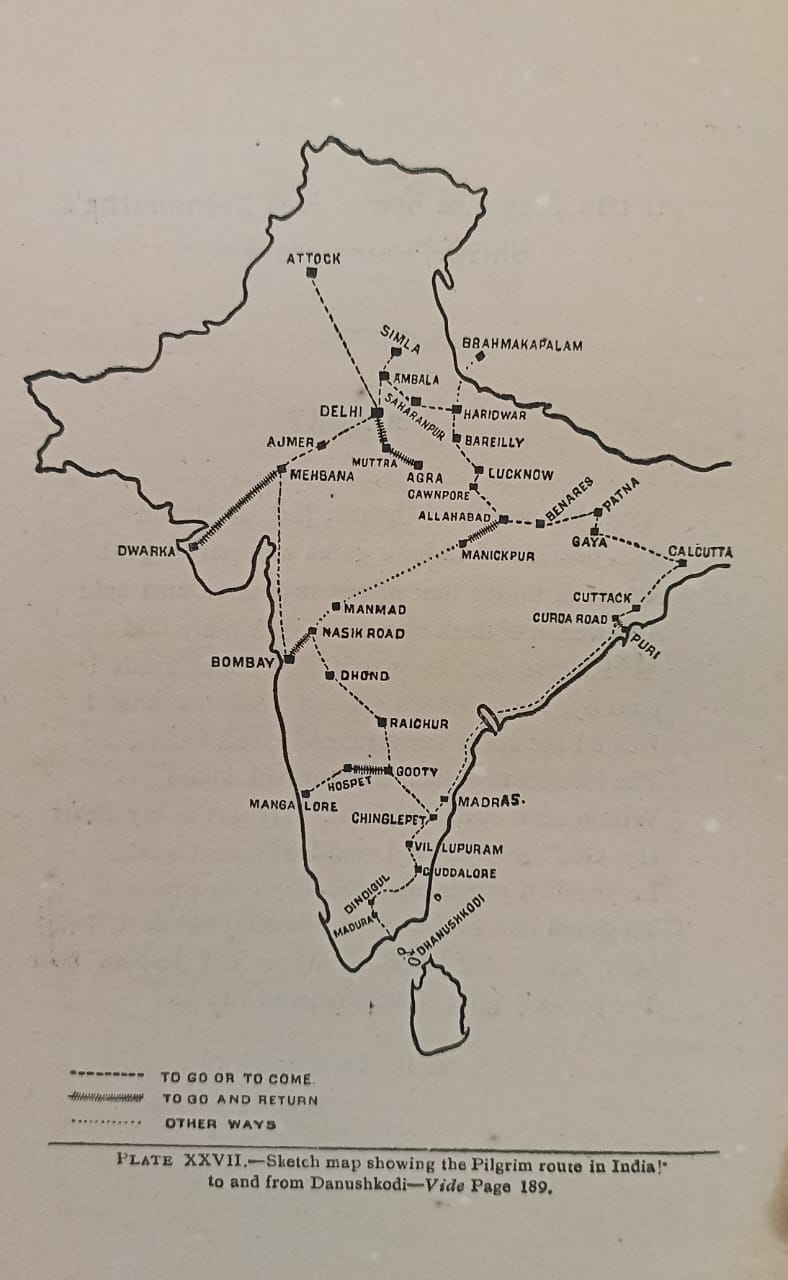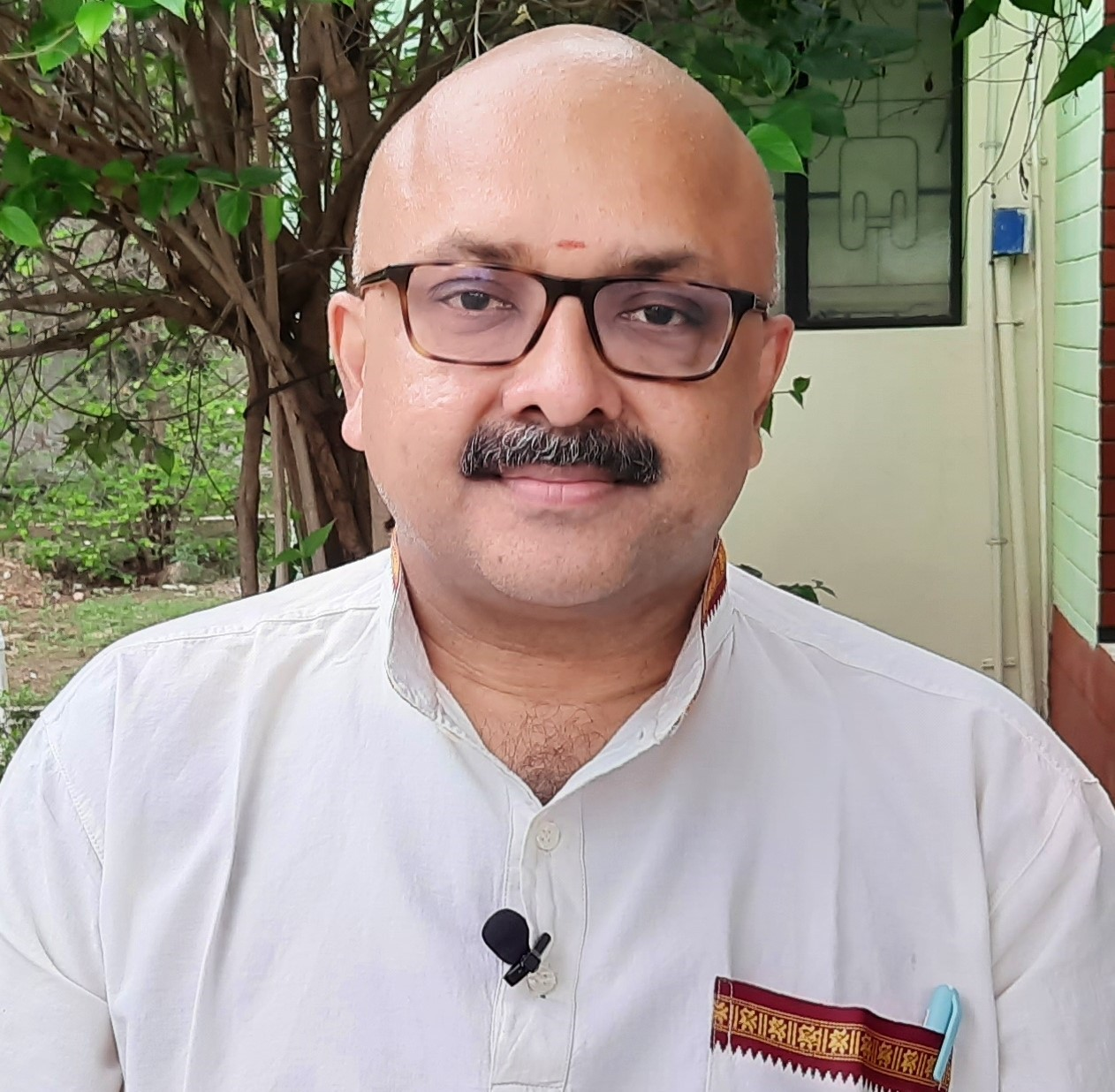
Rameswaram is a sacred island. Lord Ramanathaswamy is a permanent resident of this wonderful island. It is one of the Jyotirlinga Kshetras. The great philosopher Adi Sankara has composed a song on all the twelve Jyotirlingas and Rameswaram finds a place in this holy composition. Rameswaram is a popular Tirtha Kshethram. There are several holy wells on the island. The life of a Hindu is complete only if he or she has visited Rameswaram. Shaivaites and Vaishnavaites alike visit the holy island. The Hindus who follow the teachings of Madhvacharya consider the Sethu Madhava of Rameswaram to be an important deity. They make sure that they offer their prayers in the Sethu Madhava shrine and also have a bath in the adjoining Tirtham. The book ' Tirtha Prabandham ' by Saint Vadiraja ( 1480 - 1600 AD ) has listed this tirtham.
Dhanushkoti is an extremely important Tirtham and is located on the same island. The old Dhanushkoti was destroyed by a cyclone which occurred nearly 60 years ago. However, the devotees still continue to visit this place and offer their prayers. The place is so called due to the action of Lord Rama. he had broken the Sethu ( bridge ) with the end of his bow ( Dhanushkoti ) on the request of Vibhishana. It was to ensure that the mainland people do not invade Sri Lanka. The visit and the touch of Rama's bow had made the place quite sacred.

Purity of mind, prosperity, ability, fame, knowledge and freedom from desires will be accrued by the person who takes a bath in this junction of the seas. Every other sin ( including Brahmicide ) will get removed here. Dying on the banks of River Ganga, penance on the banks of River Narmada and giving away gifts at Kurukshetra are considered to be capable of granting enormous merit. Whereas gifts, penance and death - all three in this place bear alike the highest fruit of salvation.
 A person should bathe here and fast for three days. He should give gifts to Brahmins and offerings to the manes. The Gods of the Universe reside in Dhanushkoti Tirtham. When a pilgrim feeds a Brahmin ( learned person ) will be blessed with happiness in this world as well as the other. The sacred Tirtham especially confers salvation and bliss during the month of Magha, the sacred seasons known as Ardhodaya and Mahodaya. Also at the time of Lunar Eclipse. One can surely free himself from the debt of the pitries ( manes ) in Dhanushkoti.
A person should bathe here and fast for three days. He should give gifts to Brahmins and offerings to the manes. The Gods of the Universe reside in Dhanushkoti Tirtham. When a pilgrim feeds a Brahmin ( learned person ) will be blessed with happiness in this world as well as the other. The sacred Tirtham especially confers salvation and bliss during the month of Magha, the sacred seasons known as Ardhodaya and Mahodaya. Also at the time of Lunar Eclipse. One can surely free himself from the debt of the pitries ( manes ) in Dhanushkoti.
One of the Chiranjeevis, Aswathama got rid of the sins that were acquired by him in Dhanushkoti. He had killed people who were sleeping after the great Mahabharata war. The Upapandavas Prativindhya, Sutasoma, Shrutakarma, Shatinika and Shrutasena were killed by him. Draupadi had lost all her sons due to the heinous act of Aswathama ( son of Drona ). The relenting Vyasa had advised Aswathama to bathe at Dhanushkoti for one full month and offer his prayers to Lord Ramanatha. Aswathama fasted and observed a vigil during one night wherein he meditated on Lord Shiva. He danced and sang in praise of Lord Shiva and the good Lord appeared in front of him. Aswathama was assured that he was absolved of the sins accumulated because of the murders done by him. The learned and the sages welcomed him thereafter. Of course we must remember that we must atone for our sins.
King Dharmagupta, the son of Nandha was freed from madness after bathing in Dhanushkoti. He had betrayed his friend earlier. He lost his way while hunting and had spent the night on a tree. A bear pursued by a lion also took refuge in the same . The bear and the King came to an agreement to guard each other and slept by turns . Listening to the casualties of the lion , the prince pushed down the sleeping bear which however clung to a branch and saved itself . The bear became the sage Dyanakashata and the lion became a Gandharva when the former recounted the happenings of his former birth . They both went their way but the sage cursed the prince for his breach of faith . Paravasu , the son of Raibhya , was freed in the Setu from the sin of accidentally killing his father mistaking him for some wild beast at night .

A Brahmin youth called Sumathi was purified of the sin of Brahmahatya and theft by bathing in the Setu six months according to the advice of the sage Dhurvasa . Another Brahmin youth called Durvineetha was purified of incest by the same means , and lived a holy life thereafter . A pair of Brahmin youths who had been guilty of breaking promise and of theft towards a Brahmin , became a jackal and a monkey respectively , but by the grace of a sage called Sindhudveepa , they were advised to go to the Setu . There they were purified and got salvation . A Brahmin of the Godavari region . called Durachara degraded himself in all sorts of ways and was ultimately possessed by a Vedhala ( pisacha ) . In the course of his wandering , he happened to touch the Setu and the Vedhala left him and knowledge and purity returned .
Needless to state, the benefits of bathing in Dhanushkoti are numerous. Millions of people have come out of the clutches of their bad actions after a bath in this holy theertham. Nowadays, people use an SUV, sports utility vehicle in order to travel to dhanushkoti. The vehicle passes through beach sand and thin slates of flowing sea water. On reaching dhanushkoti one can get to see the destruction that had occurred decades ago. The manhood remains of railway tracks and the village devoid of life would remind people about the futility of their own actions. A few fishermen are found in this part and life is hardy. But sanathani bhartiya brave the journey with the soul idea of redeeming the souls of their elders from the cycle of repeated births. Dhanushkoti continues to be held very sacred by the people of India. People belonging to all the Indic faiths visit dhanushkoti at least once in their lifetime. A visit to this holy theertham sure offers salvation and contentment for the devout. It is the moral and ethical responsibility of every Indian to lead a dharmic life and also preserve the holy waters and the land at dhanushkoti.

Mr. Rajesh Govindarajulu is one of the founding members of The Verandah Club Pvt. Ltd. He is a leading columnist, historian, jeweler, entrepreneur, and a heritage enthusiast who is earnestly working to revive the past in the light of the present. Experiential learning about the history of Coimbatore is his main course of interest and he is also a panel member of many colleges in the city.
NEXT ARTICLE